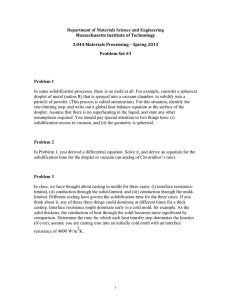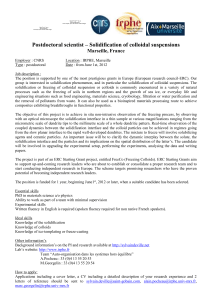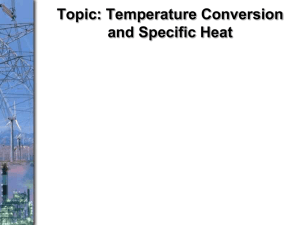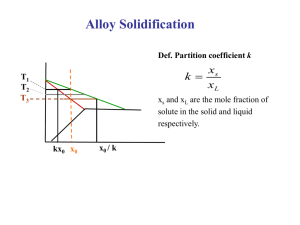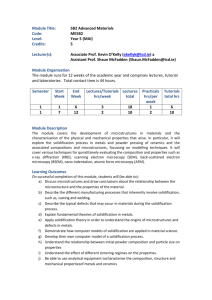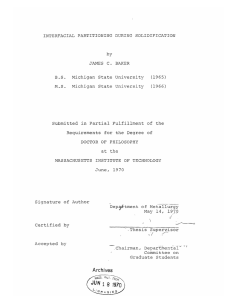solidification
advertisement
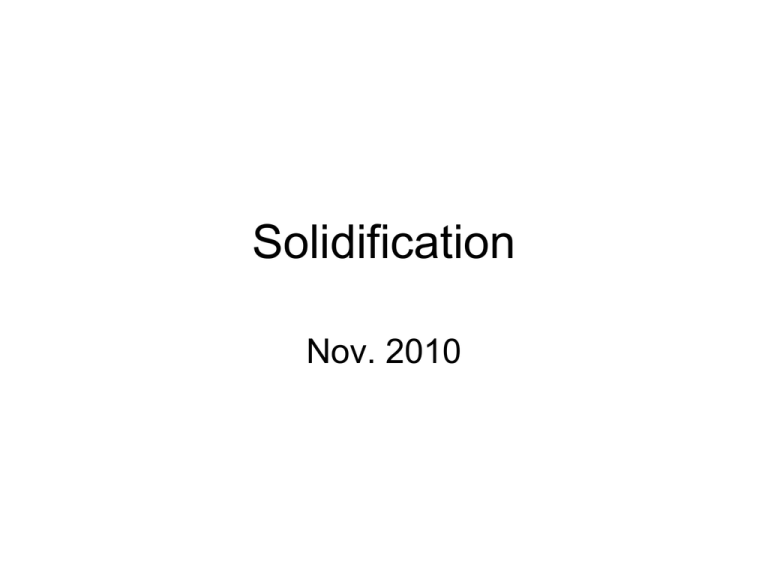
Solidification Nov. 2010 • Rapid Solidification (105 K/s) • Rapidly cool or quench to produce amorphous or glassy structure (metallic glass) Rapid Solidification • Cooling Rate >104 -107 oK/s • By processes such as: Atomization, melt spinning, rollerquenching or plasma spray or laser or electron beam surface treatment • Non-eqm phase, no thermo. Restrictions, exceed solubility limits, melt solidifies without any chem changes. • Crystalline or amorphous (improved mech. properties) • Microsegregation-free structures • Using powder metallurgy to process the materials. Solid State Sintering Scheil equation • In metallurgy, the Scheil-Gulliver equation (or Scheil equation) describes solute redistribution during solidification of an alloy. This approach approximates non-equilibrium solidification by assuming a local equilibrium of the advancing solidification front at the solidliquid interface. This allows the use of equilibrium phase diagrams in solidification analysis. • Unlike equilibrium solidification, solute does not diffuse back into the solid and is rejected completely into the liquid. Complete mixing of solute in the liquid is also assumed as a result of convection and/or stirring. Derivation • The following figure shows the solute redistribution for nonequilibrium solidification where there is no diffusion of solute in the solid and complete mixing of solute in the liquid. • and Ds = 0.0 and DL = 00 • Equilibrium is assumed at the interface which allows the use of an equilibrium phase diagram. • The hatched areas in the figure represent the amount of solute in the solid and liquid. Considering that the total amount of solute in the system must be conserved, the areas are set equal as follows: • . • Since the distribution coefficient is • (determined from the phase diagram) • and mass must be conserved • the mass balance may be rewritten as at • Zone refining • a process of purifying any of various metals and other materials, as germanium or silicon, by passing it in bar form through an induction coil. • methods of purifying crystals, in which a narrow region of a crystal is molten, and this molten zone is moved along the crystal (in practice, the crystal is pulled through the heater). The molten region melts impure solid at its forward edge and leaves a wake of purer material solidified behind it as it moves through the ingot. The impurities concentrate in the melt, and are moved to one end of the ingot. Liquid moves from left to right during melting in the float-zone crystal growth process The number of impurities in the liquid changes in accordance with the expression below during the movement dx of the molten zon Solidification of Ingots and Castings Segregation The non-uniform distribution of impurities or alloying elements. The degree of segregation depends not only on the chemical composition of the alloy, but also on the rate of cooling, both of the ingot as a whole, and of each individual point within the mass. For example, near the surface, where the rate of cooling is rapid, the segregated impurities are trapped in the rapidly growing crystals. Fur- their inside the ingot, where the cooling is slower, the segregates will collect together and produce the so-called ghosts, or they may tend to rise to the surface and collect in the scrapped ingot head. In normal segregation, the constituents with the lowest melting points concentrate in the last portions to solidify, but in inverse segregation this is reversed. The segregation tends to form in bands sloping inwards to the top of the ingot (A segregate) and at the same time, due to shrinkage, it takes a V shape (V segregate) along the upper part of the ingot axis. Microsegregation In welding, as the heat source interacts with the material, the severity of thermal excursions experienced by the material varies from region to region, resulting in three distinct regions in the weldment. These are the fusion zone (FZ), also known as the weld metal, the heat-affected zone (HAZ), and the unaffected base metal (BM). The FZ experiences melting and solidification, and its microstructural characteristics are the focus of this article. The microstructure development in the FZ depends on the solidification behavior of the weld pool. The principles of solidification control the size and shape of the grains, segregation, and the distribution of inclusions and porosity. Solidification is also critical to the hot-cracking behavior of alloys. Sometimes, it is convenient to consider the FZ as a minicasting. Therefore, parameters important in determining microstructures in casting, such as growth rate (R), temperature gradient (G), undercooling (DT), and alloy composition determine the development of microstructures in welds as well. Figure 3 (a-left). The thermal and the fraction-of-solid fields in a continously cast steel slab. (b-top right) The grain structure in a steel slab transverse crosssection,2-4 with only columnar grains up to the center line. (c-bottom right). Equiaxed grains that result if inoculation is promoted (by electromagnetic stirring for example). Continuous Casting/Welding Solidification d2T/dx2 + d2T/dy2 + d2T/dz2 = 2 Ks v (dT/(d(x-vt)) l (x ,y,z) a q/(Ks vt) v welding speed/velocity of plate withdrawal Ks Thermal conductivity of metal t thickness of plate being welded or cast q the rate of heat input http://www.tms.org/pubs/journals/JOM/0201/Thevoz/Thevoz-0201.html
